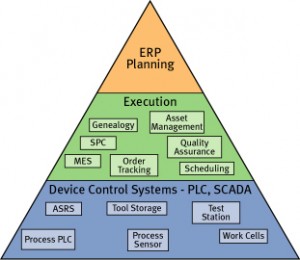Manufacturing Execution Systems (MES)

As part of my job I have often been tasked with gathering information pertaining to machine or production line performance, production data or implementation of SCADA systems. Most of the time my job ends at the plant floor and others are responsible for integration of the data collection into the business side of the plant. So what happens to information collected on my OEE (Overall Equipment Effectiveness) and machine production screens?
Information technology has changed the way manufacturing operations are managed. Manufacturing Execution Systems (MES) have been refined to include a host of techniques and software programs to help manage everything from production, machine maintenance and product definitions to logistics and product quality. Many of these concepts originated in the 1980’s as PLCs and DCSs improved to where the collection of production and machine operation data could be automated. Before this data had to be collected by humans recording this information on paper. It was laborious, time consuming and subject to error. Before the advent of PCs the information had to be digested by management which took even more time. As technology progressed the Manufacturing Enterprise Solutions Association (MESA) introduced structure to these operations defining 11 functions within the scope of MES. A level based system was refined as shown in the above diagram. The top level was the Enterprise Resource Planning (ERP) which used production requirements such as finance, raw materials, customer service and sales and manufacturing equipment to define the information that was required to be collected. Levels below this were defined in decreasing order and includes other systems within each including level 3, Manufacturing Operations Management Systems (MOMS). This includes Laboratory Information Management System (LIMS), Warehouse Management System (WMS) and Computerized Maintenance Management System (CMMS).
Systems within level 2 include Supervisory Control And Data Acquisition (SCADA), Programmable Logic Controllers (PLC), Distributed Control Systems (DCS) and Batch Automation Systems. Below these systems may be “smart” sensors or motor control components or even involve manual operator input. Many of the communications and device control networks were developed in response to requirements of MES. OLE for Process Control (OPC) is an example of this.

The above screen is from a project I did in the mid-1990s. The project started out as just collecting a few data points from a press line but quickly evolved as the customer decided to add information from other processes. This screen ended up being a toplevel menu where the customer could drill down into a physical area of the plant to obtain information from particular machines on OEE or production. It was eventually integrated into the AS-400 system along with SAP software to begin implementation of an MES system.
It was also the start of a beautiful relationship with some new acronyms!

0 Comments on “Manufacturing Execution Systems (MES)”